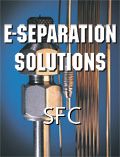SFC
Joining us for a discussion of SFC this month are Allan Heckenberg of Aurora SFC Systems; David Wetherell of Waters Corporation; DJ Tognarelli of JASCO, USA; and Pat Sandra of Research Institute for Chromatography, Kortrijk, Belgium.

With the resurgence of green chemistry and the continued spike in acetonitrile prices, SFC has seen something of a renaissance in recent years.
Joining us for a discussion of SFC this month are Allan Heckenberg of Aurora SFC Systems; David Wetherell of Waters Corporation; DJ Tognarelli of JASCO, USA; and Pat Sandra of Research Institute for Chromatography, Kortrijk, Belgium.
What's new in the SFC industry? What trends do you see emerging?
Heckenberg: Two really significant trends have occurred in the last year. HPLC-like performance for analytical SFC permits a dramatic growth in applications. Chemists are no longer limited by system, signal to noise, retention precision, dynamic range, method validation, or ease-of-learning problems with software. More recently, 2-µm materials have been shown to give exceptional results for SFC, and SFC–MS — with orthogonal selectivity to UHPLC separations — with similar separation power.
Wetherell: The availability of new column chemistries is quite exciting and appears to be gaining momentum as companies introduce new stationary phases for both HPLC and SFC. In addition, SFC is now becoming more of a routine support tool for achiral work and there is a great deal of movement towards automated mass directed purification platforms.
Tognarelli: The SFC industry is seeing the exploration of more universal detectors to expand the applicability of SFC beyond the established small molecule chiral separations. Evaporative light scattering, flame ionization, and mass spectrometry are among the detectors commonly being coupled to SFC to not only widen applications, but to increase sensitivity. The coupling of MS has led to an increase in small molecule achiral separations as a faster and greener alternative to HPLC. Recently, biofuel application research has started to emerge using green chromatography to analyze a green fuel.
Sandra: SFC has been around for over 25 years, but despite its many claimed "theoretical" advantages over normal-phase HPLC, is only intensively used for some niche applications, e.g. chiral separations in the pharmaceutical industry. In recent years, its popularity has increased. This has been ascribed by system advances but, in our opinion, one of the main reasons is its green character. SFC is environmentally friendly and minimizes the use of toxic organic solvents and additives, with their concomitant risks of laboratory worker exposure and disposal problems. Green is also a main reason why the big companies re-entered the SFC market.
Which applications benefit the most from the advantages of SFC?
Heckenberg:In the past five years, chiral and preparative methods have been the core of SFC applications. Looking into the near future, due to recent hardware breakthroughs, many normal-phase or reversed-phase achiral separations will be revised to SFC, due to solvent savings, efficiency, throughput, and selectivity advantages. New and improved phases will expand the application base further — pharmaceutical, industrial, food, and environmental applications will all benefit.
Wetherell:Certainly chiral applications benefit a great deal from this technology and SFC provides greater speed and throughput for the analysis and purification of these compounds, with less waste, and without the necessity of using many organic solvents. In addition, there are a number of applications outside of the pharmaceutical arena that would benefit greatly from SFC technology, and we need to focus more on these areas going forward.
Tognarelli: For years SFC has been driven by its speed, offering a dramatic reduction in analysis time for the chiral screening process. The preparative world has more recently acknowledged not only the analysis speed, but the green aspect of SFC in the reduction of solvent consumption and waste production. Prep-SFC fractions are collected in much smaller volumes due to the natural expansion of CO2, while still offering very high recovery yields. Alcohols are commonly used as a cosolvent to CO2, eliminating the need to lyophilize the fractions, allowing for very easy dry fraction recovery.
Sandra: Drug discovery and small molecule analysis in general.Although there have been some publications related with bioanalysis(peptides) ... there is no future for SFC in life sciences.
What are some of the challenges facing SFC research and development and how can they be overcome in the future?
Heckenberg:The fundamentals of pumping and pressure regulation have been solved. Improvements in detection, appropriate column ovens, and switching, software (including method development), and fraction collection are all challenging areas that need more work.
Tognarelli: The expansion of applications beyond the established chiral purifications is a significant challenge to the SFC industry. Various industries recognize the advantages SFC can offer, but are reluctant to explore it, fearing it is not applicable to their samples. With SFC coupling to evaporative light scattering detection, flame ionization detection, and mass spectrometry and the continual expansion of achiral columns specifically designed for certain compound classes, I believe SFC will naturally expand and find its way into industries previously thought to be limited to HPLC.
Sandra: Installation qualification (IQ), operational qualification/performanceverification (OQ/PV), and system suitability testing in SFC should soon be atthe same level as for state-of-the-art GC and HPLC. In an era in which fundamental knowledge and know-how in separation scienceare declining worldwide, the strength of SFC (i.e. large numbers of variablesto tune the selectivity for a specific application) appears to be theweakness for neophytes in the field! Method development in SFC should besimpler ... Simplified Fluid Chromatography!
What is one change/improvement you hope to see in the SFC industry over the next few years?
Heckenberg:The acceptance of SFC as a routine tool for all HPLC users. SFC should not been seen as the "when nothing else works" technique.
Wetherell:We would like to see greater acceptance of SFC technology in the mainstream, but as manufacturers, we need to focus more on applications and solutions-based development in order to help our customers recognize the value of SFC as another extremely useful tool in the laboratory.
Tognarelli: As SFC hardware reliability has caught up to that associated with HPLC, I would like to see the continual expansion of new and diverse SFC research to eventually match the wide applicability of HPLC.
Sandra: Interfacing with mass spectrometry should be simpler ... and this can easilybe done via a fixed restrictor instead of a back-pressure regulator!
If you are interested in participating in any upcoming Technology Forums please contact Associate Editor Meg Evans for more information. Next month’s forums will focus on the Software and CE markets.
Regulatory Deadlines and Supply Chain Challenges Take Center Stage in Nitrosamine Discussion
April 10th 2025During an LCGC International peer exchange, Aloka Srinivasan, Mayank Bhanti, and Amber Burch discussed the regulatory deadlines and supply chain challenges that come with nitrosamine analysis.








